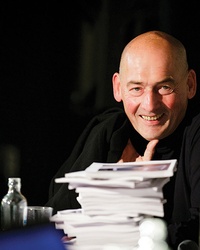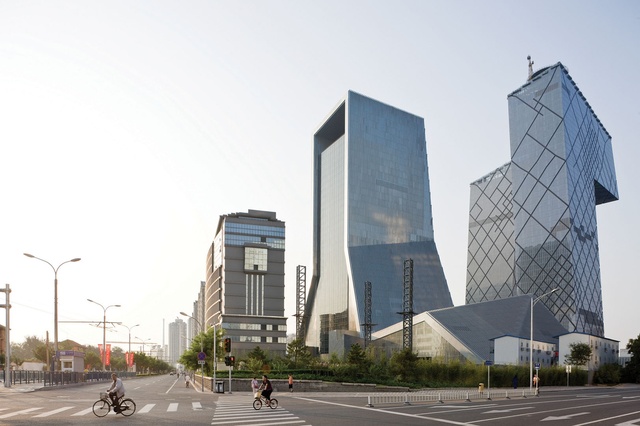Submitted by WA Contents
Rem Koolhaas: National identity in architecture
United Kingdom Architecture News - Mar 26, 2014 - 12:22 6917 views

A montage by Koolhaas as Venice curator, illustrating the conformity of contemporary architecture worldwide, and the inherent loss of national identities and vernacular.
The 2014 Venice Architecture Biennale, curated by Dutch architect and founding partner of OMA Rem Koolhaas, will examine “the evolution of national architectures in the last [sic] one hundred years.” In an interview fromArchitecture Australia March/April 2014, Koolhaas spoke to Andrew Mackenzie about this trade-off between regionalism and globalism in architecture, his studio’s work and his involvement with research and publishing through AMO.
Andrew Mackenzie: Your proposition for this year’s Venice Architecture Biennale asks whether national identity has been, as you say, “sacrificed to modernity.” Some might view this as a project of reclamation, not unlike Frampton’s regionalism. How would you differentiate your proposition from Frampton’s?
Rem Koolhaas: Well, Kenneth Frampton is a smart guy, but the problem is that he looked at regionalism as an antidote to cosmopolitan development. In so doing he perverted the cause of regionalism, because suddenly regionalism was mobilized as a private cause that couldn’t be sustained. However, the question of national identity is an open one. For instance, at first sight [the Netherlands] is a very internationalist country, but looking closely you can see an enormous return of not vernacular, but quasi-vernacular architecture and quasi-old fortresses that are newly built with a national flavour. Look at Zaandam and that huge assemblage of so-called vernacular buildings.

Rem Koolhaas, legend, curator of the 2014 Venice Architecture Biennale. Image: Fred Ernst / Courtesy of OMA
I understand this very well, because the vast majority of so-called modern architecture now is really a kind of gimmicky modernism and this creates space for traditionalism to be gimmicky too. It’s like a set of communicating vases, where movement in one translates directly to movement in the other. I see this less from an architectural perspective than from a social or anthropological one. Recent years have seen an extraordinary growth in what I would call quasi-vernacular, particularly across Europe.
AM: If Zaandam represents a kind of quasi-vernacular, what qualities, quasi or otherwise, would you ascribe to yourself as a Dutch architect?
RK: It’s at the same time a simple and a complex question. In its most blatant sense I have a huge sympathy for orthogonal organizations and this, at some level, is very visible in the work. But at the same time there is a counter force, as [a result] of my early years in Indonesia. My parents took me to Jakarta when I was eight. I was transplanted from a ruin to an extremely chaotic tropical city that was in a state of euphoria because of its recent independence. I went to an Indonesian school, spoke Indonesian and behaved more or less like an Asian child. When I returned to a totally reordered [Netherlands] at the age of twelve, I never felt comfortable in that state of completion. From there many of my interests are clear. I was exposed to Dutchness as a young child, then its counterpart. So I would say that I am slightly less dogmatic than the Dutch. You might say that I am as attracted to Mondrian as to batik and, in this, I would say that the work is an oscillation between the two.
AM: Is this also why you are interested in Asia? I’m thinking particularly of your collaboration with Hans Ulrich Obrist on the book Project Japan: Metabolism Talks.
RK: Yes, in particular China and Japan are very important countries for me. Japan [because it’s] the first non-Western country where there was an architectural avant-garde. My interest in Metabolism is an interest in how globalization rearranged architectural areas of initiative, in the sense that you can no longer claim that the Western city is the model that fits all. I was interested in how this end of the Western hegemony was already announced in Japan in the 1960s.
AM: Your work in China has been somewhat controversial, due mainly to assumptions that are made in the West about what one might call the client’s values. How do you respond to criticism regarding your engagement with communist China?
Of course we do not participate in any project where we fundamentally reject the values of the client. We interpret the client’s values, not always in a literal way.
RK: Of course we do not participate in any project where we fundamentally reject the values of the client. We interpret the client’s values, not always in a literal way.
In the case of China, I had visited it for the first time in ’95, years before the CCTV competition in 2002. Working with Harvard students I had developed more or less an understanding of what was going on and where the country was moving. This led me to the political conviction that all of us have a huge stake in how things develop in China. It is incredibly stupid for Europe to point fingers and insist on Europe as the only model of democratic behaviour.
After the destruction of the Berlin Wall in ’89, there were a lot of expectations that the world would turn into a seamless tapestry of market economy and liberalism, which to me was clearly not going to happen. On the contrary, what became obvious was that the market economy would be joined by a very diverse patchwork of different systems and different degrees of democracy. So essentially I said yes, not so much to CCTV, but to participation in the development of China.
I was confident that the Chinese media would, in parallel, change a lot as well. Now CCTV has an English channel, which in itself means that it has to be more global and engage meaningfully in a global English-speaking world. Interestingly, the fire that happened in the [adjacent TVCC building] contributed to the modernization of the media, because for the first time they apologized to the Chinese public and they had no choice but to convey their own disaster as a news story.

OMA’s TVCC tower (centre), with the neighbouring CCTV building (right). Image: Iwan Baan / Courtesy of OMA
AM: For Venice this year, you have curated a biennale that focuses on “the inevitable elements of all architecture.” Can you tell me more about the forensic way you have pulled apart the contents of “all architecture,” as you describe it?
RK: I have, in the past, written a lot about the city and the shifting ways that cities are seen. When I started [practising architecture], the Western city was considered the measure of all things. I tried to create an openness to the situation in other countries. Now, after all these years, for me it is interesting to look at pure architecture features.....Continue Reading
> via ArchitectureAU
